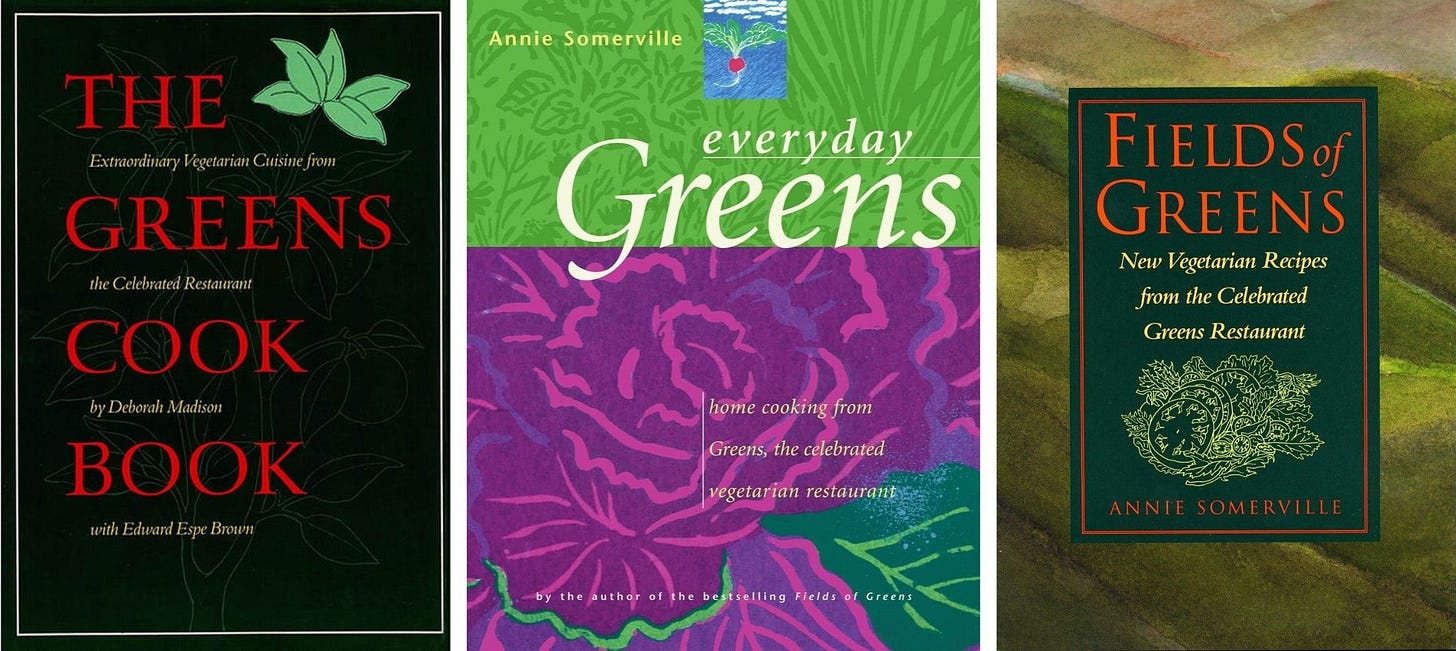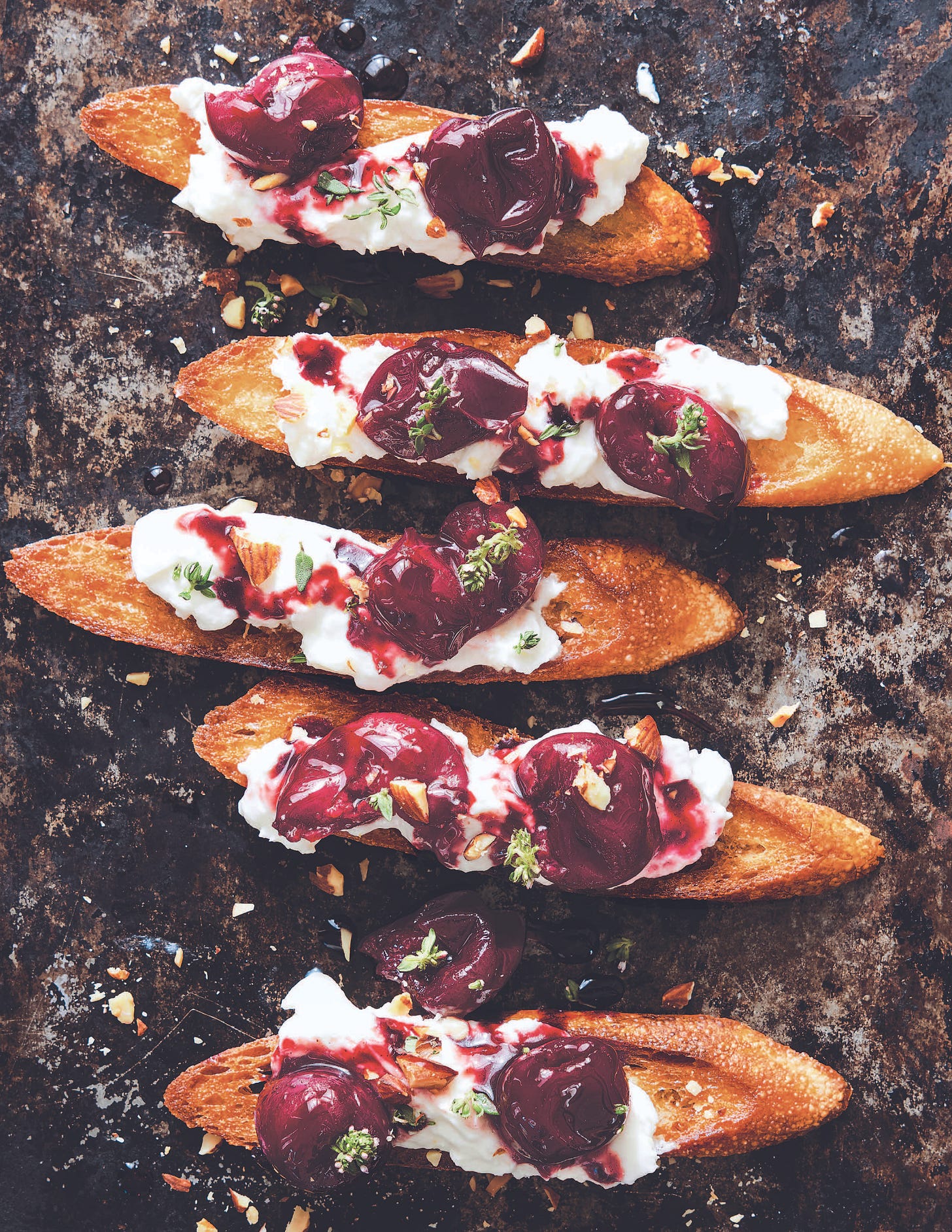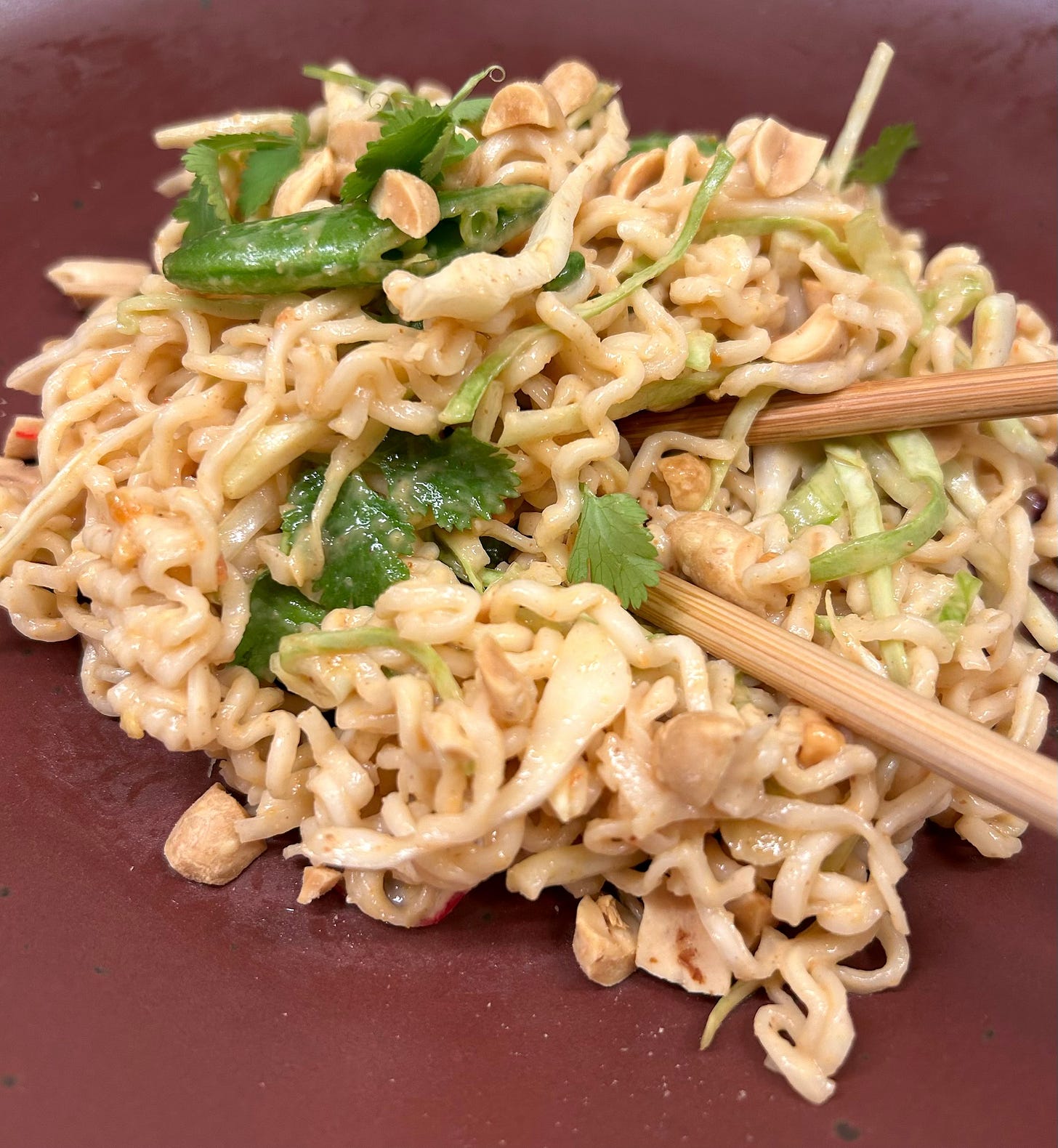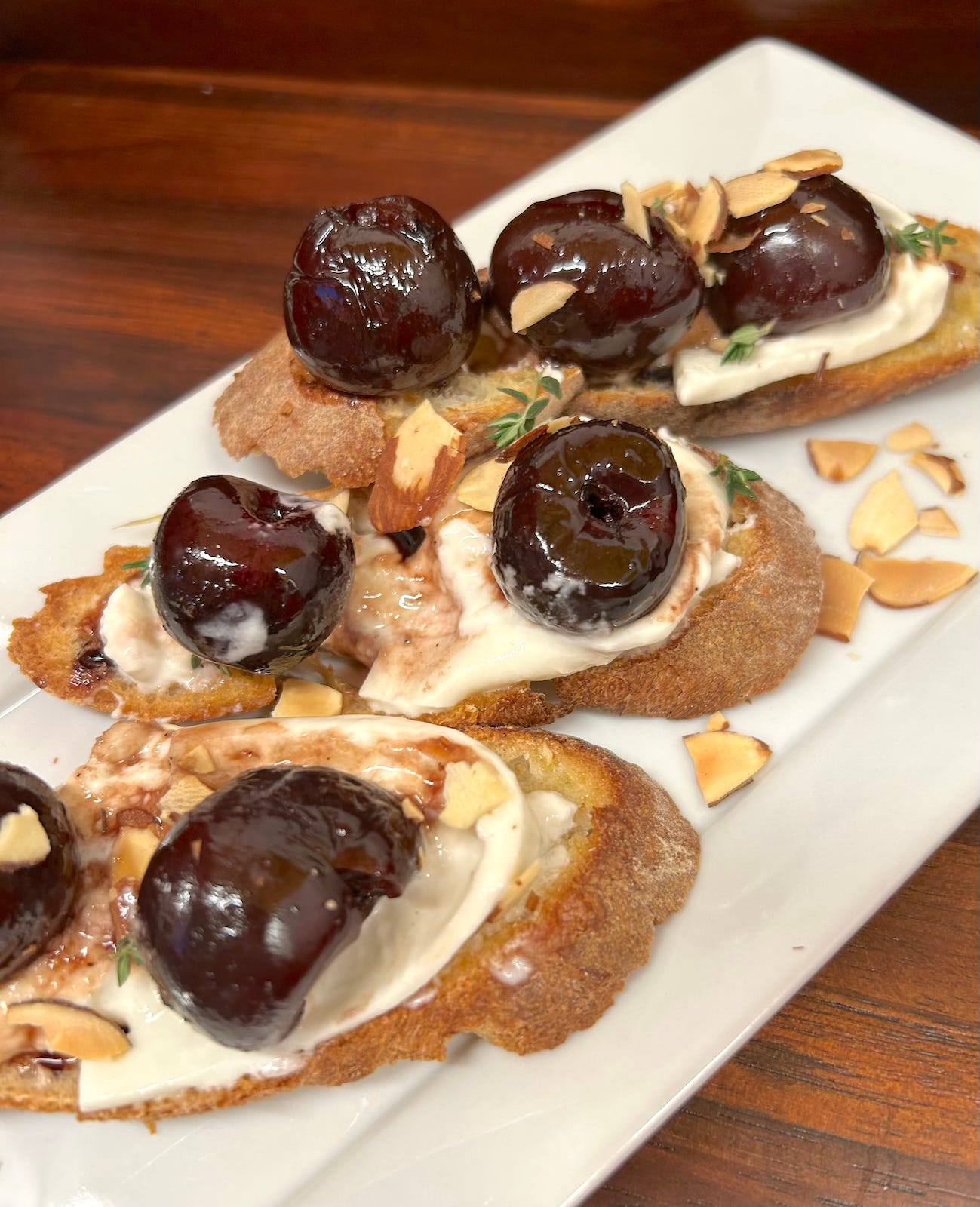Oodles of noodles and cherries on top
Leaning into spring fever with two new spring recipes plucked from Greens, the famed restaurant that celebrates vegetables of every season
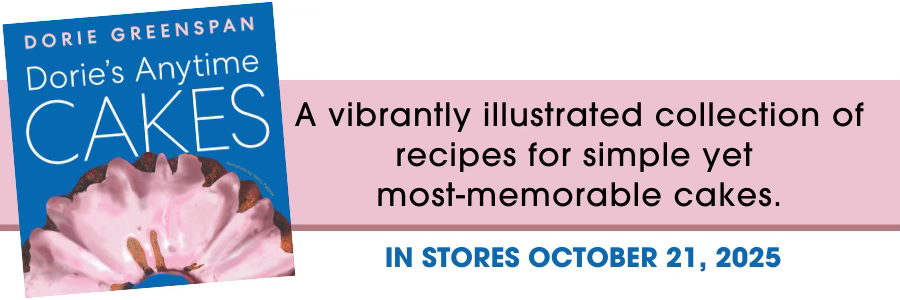
Hello! Hello!
Maybe it’s spring fever, but I’m more impetuous than ever. You? I’m having trouble settling down. Having trouble keeping my mind on one thing for a long time. I’m flighty and flitty and sometimes a little dreamy. And while I take forever to make up my mind, I change it in the time it takes a butterfly to flutter off a leaf. Which is how we ended up having Celery & Peanut Noodle Salad for dinner instead of the chickpea situation I’d planned.
Late one afternoon last week, I got a sneak-peek copy of Seasons of Greens by Katie Reicher, the chef of Greens restaurant in San Francisco (it comes out April 22 — you can preorder it on Bookshop / B&N / Amazon). I saw the recipe and saw that I had everything I needed for it. Good thing I doubled the recipe — Joshua and Linling ended up coming here in time for dinner. We all loved it. Loved it enough that I’ve since made it again. (There’s more about the noodles and the pickled cherry toasts I made — recipes too — further down.)

I love when a snap decision turns out to be a delicious one. But later, as I read through the book, I realized that I could have snapped on dozens of other recipes and been just as delighted. It’s such an appealing cookbook! And it’s the fourth from the legendary vegetarian restaurant. Turns out I have the other three — yes, I was surprised.
40 years of food and books
The Greens restaurant website has a lovely timeline of the legendary vegetarian restaurant, its roots in the San Franciso Zen Center and Tassajara, and its history of having women chefs head the kitchen. I knew about the restaurant in its early days, when Deborah Madison, a leading light in vegetarian cooking, was the founding chef, and I’d had lunch there sometime in the 1990s, when Annie Somerville was cooking — she was Greens’ chef for over 30 years. And so, when this new book from Katie Reicher arrived, I was excited to see how things had changed over the decades. There’s no easy way to sum it up, but Reicher, who’s been at Greens for ten years, did something marvelous: she held onto the kitchen’s legacy and added her own fresh, modern, sparkle and shine. And the book publishers did, too.
When The Greens Cookbook, written by founding chef Deborah Madison with Zen priest Edward Espe Brown (author of the Tassajara Bread Book), came out in 1987, it was rare to find serious cookbooks with photographs — in fact, readers didn’t expect them and those of us who loved cookbooks and loved working from them, learned how to imagine what the dishes would be like just by reading the ingredient lists and the instructions. Somehow, that book managed to be elegant with just a few one-color (green, of course) illustrations on the chapter pages.
The second book was Fields of Greens by Annie Somerville, published in 1993. Again, there were no photographs, but there were highlights of green on every page and some green illustrations here and there as well as on the chapter openers.
Somerville’s second book, Everyday Greens, came out in 2003 (Bookshop.org / B&N / Amazon). It had a different look because it had touches of color on every page and more abundant colorful illustrations on more pages. But still, no photographs.
With Seasons of Greens comes brightness. Glossy pages, white spaces and photographs that are as seductive and inviting as the recipes themselves. The food looks grabbable. More important, it looks — and is — doable. These are recipes for today. And every day.
There’s so much to learn in the book. So much to read. And best of all, so much to cook. And bake. I’ve got my eye on the Sesame-Brown Sugar Cookies. Pan-bangers, they are. They look so good. So do the Strawberry Rhubarb Squares — and soon it’ll be rhubarb time here in Connecticut.
Those noodles
They’re billed as a salad and rightly so, there are as many vegetables as there are noodles. The star is meant to be celery, a vegetable that so many of us might take for granted, but not Katie Reicher. I’ve included her thoughts on the king-of-crunch in the recipe below, but up here, I’ve got a confession to make — as great as the celery is in the dish, all of the ingredients shine. I’m guessing that just as I did, you’ll think of cold sesame noodles when you look at the recipe. You’re kind of right, but kind of not — because the salad’s got so many great textures and because the sauce clings to the noodles in a different way (it seems lighter to me), the salad becomes just what it’s meant to be: a new kind of delicious. None of us could get enough of it.
And those cherries
This was such a pretty dish that I couldn’t resist it. My market had early cherries — I know I should have waited until they were truly in season, just as they do at Greens, but refer back to being impetuous. I made the toasts with locally-made burrata and very locally made bread — Michael made the baguette. Next time I might use ricotta — it would also be nice. I think this is a little arts-and-crafts dish that invites variations. We nibbled the toasts in the kitchen with white wine, but when the weather gets nicer, I’m planning on making them an outdoor treat to have along with rosé or tart lemonade.
Three cheers for the change of seasons and a new cookbook to keep up with them.
💜 xoxoDorie is a reader-supported newsletter. Upgrade or invite more friends.
📚 You can find more recipes in my latest book Baking with Dorie, and get ready for Dorie’s Anytime Cakes by pre-ordering at Bookshop.org, Barnes & Noble or Amazon.
ℹ️ Click here for helpful links while using Substack.
CELERY AND PEANUT NOODLE SALAD
Adapted from Seasons of Greens: A Collection of New Recipes from the Iconic San Francisco Restaurant © 2025 by Katie Reicher. Reprinted by permission of Weldon Owen, an imprint of Insight Editions. All rights reserved.
Get your copy at Bookshop.org // B&N // Amazon
Here’s what Katie has to say about the recipe:
My dream is to live in a world where people rejoice over the crisp, vegetal, and refreshing glory that is celery. While often overlooked as merely an ingredient in vegetable stock, celery is an incredible vegetable to use in salads, especially when served with something creamy and nutty like peanut butter. (The creator of ants-on-a-log was really onto something!) I particularly love this salad with the addition of fresh edamame, a delicacy that is only available for a few weeks every October.
GOOD TO KNOW BEFORE YOU START
About peanut vinaigrette — a confession: Because the first time I made the recipe, I had only enough peanuts to either make the vinaigrette or the topping, I made a decision that worked well, even if it wasn’t exactly as the recipe directed: I used the peanuts in the salad and substituted 70 grams of all-natural (peanuts-only) chunky peanut butter for the nuts in the dressing. I added only a drizzle of oil to the vinaigrette because the peanut butter gave me a consistency I liked. And, because I started with peanut butter, I did everything by hand.
Other unauthorized, but nice substitutions: I didn’t have the specific kind of noodles that Reicher recommended, so I used what I had, curly Chinese wheat noodles (China Bowl Chinese Noodles). I didn’t have purple cabbage, so I used green. And I used the radishes I had because I didn’t have Flambeau radishes. As a cookbook author, I hope that Katie agrees with me — I’d rather have someone make something that keeps the spirit of what I’ve written than not to make it at all.
Katie on celery:
Celery is yet another incredibly underrated vegetable. While it firmly has its place in things like mirepoix, it's seldom used as the main ingredient in a dish. When paired with the right components, celery offers a marvelously juicy crunch, making it ideal for cold, bright salads.
Serves 2 to 3
INGREDIENTS
For the noodle salad
One 5-ounce (142 grams) package soba noodles, ramen noodles, or rice noodles, cooked according to package directions and cooled (see above)
4 ribs celery, sliced thinly on a bias
1/4 head purple cabbage, shredded finely (see above)
4 ounces (115 grams) snap peas, trimmed and halved on a bias
4 to 6 red Flambeau radishes, sliced very thinly (see above)
2 scallions, sliced thinly on a bias
1 red Fresno chile, sliced into thin coins
1/4 bunch cilantro, stems removed
1 cup (140 grams) toasted peanuts
For the peanut vinaigrette
1/2 cup (70 grams) well toasted peanuts (see above)
1/4 cup (68 ml) peanut oil or canola oil (see above)
3 tablespoons brown sugar
2 tablespoons rice vinegar
1 1/2 teaspoons salt
2 teaspoons sambal oelek
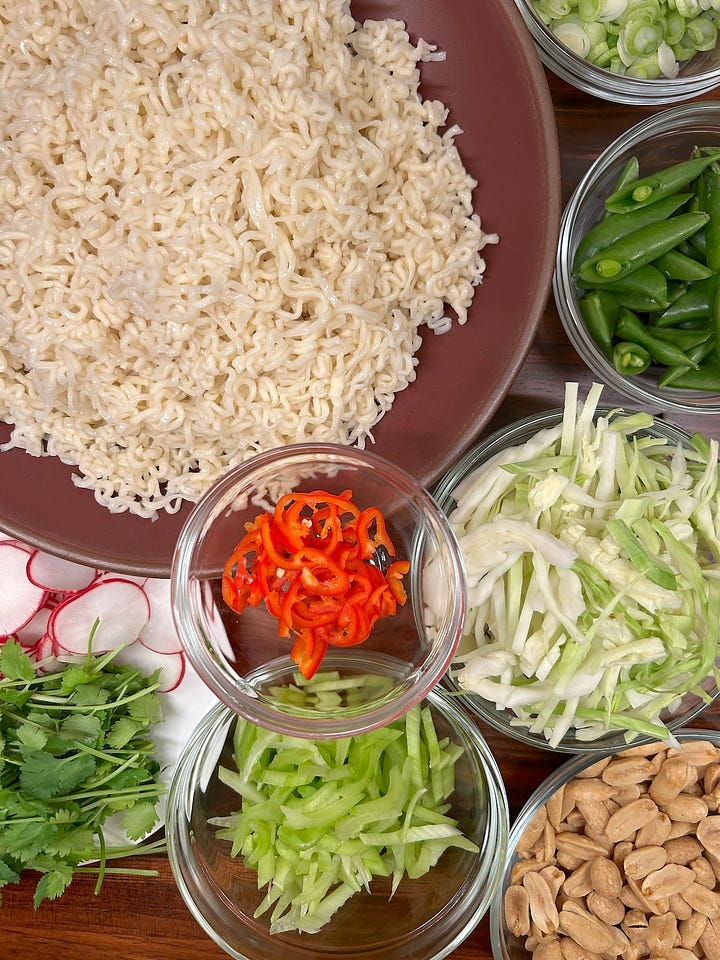

DIRECTIONS
Combine the soba noodles, celery, cabbage, snap peas, radishes, scallions and Fresno chile together in a bowl. Add half of the cilantro leaves and peanut vinaigrette to taste. Garnish with the toasted peanuts and remaining cilantro leaves.
To make the vinaigrette (see above): in a food processor or mortar and pestle, grind the peanuts together until they form a thick, shiny, and somewhat chunky paste. Add to a small bowl with the remaining ingredients and stir well to combine.
BURRATA TOASTS WITH BALSAMIC CHERRIES
Adapted from Seasons of Greens: A Collection of New Recipes from the Iconic San Francisco Restaurant © 2025 by Katie Reicher. Reprinted by permission of Weldon Owen, an imprint of Insight Editions. All rights reserved.
Get your copy at Bookshop.org // B&N // Amazon
Here’s what Katie has to say about the recipe:
Burrata toast is a delightful way to showcase the season's best fruits. In the springtime, when cherries take over the markets, we like to serve a big slice of burrata toast at brunch. This recipe trades the large slice for smaller slices cut from a thin baguette, making it ideal for entertaining, or even just an afternoon snack.





